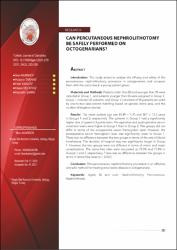CAN PERCUTANEOUS NEPHROLITHOTOMY BE SAFELY PERFORMED ON OCTOGENARIANS?
Özet
Introduction: This study aimed to analyze the efficacy and safety of the percutaneous nephrolithotomy procedure in octogenarians and compare them with the outcomes in a young patient group.
Materials and Methods: Patients older than 80 and younger than 90 were included in Group 1, and patients younger than 65 were assigned to Group 2. Group 1 included 45 patients, and Group 2 consisted of 90 patients recruited by one-to-two case-control matching based on gender, stone area, and the number of staghorn stones.
Results: The mean patient age was 81.89 +/- 1.70 and 38.7 +/- 12.5 years in Groups 1 and 2, respectively. The patients in Group 1 had a significantly higher rate of systemic hypertension. Pre-operative and post-operative serum creatinine levels were higher in Group 1 than in Group 2. The groups did not differ in terms of the preoperative serum hemoglobin level. However, the postoperative serum hemoglobin level was significantly lower in Group 1. There was no difference between the two groups in terms of the rate of blood transfusions. The duration of hospital stay was significantly longer in Group 1. However, the two groups were not different in terms of minor and major complications. The stone-free rates were calculated as 73.3% and 77.8% in Groups 1 and 2, respectively. There was no difference between the groups in terms of stone-free rates (p = 0.567).
Conclusion: The percutaneous nephrolithotomy procedure is an effective and safe method for treating renal stone disease in octogenarians.


















